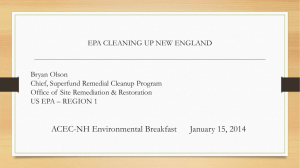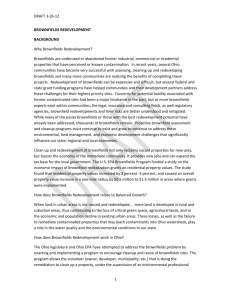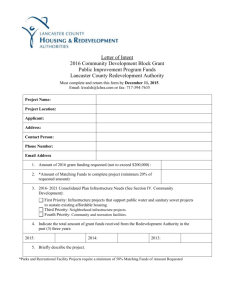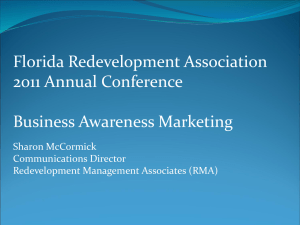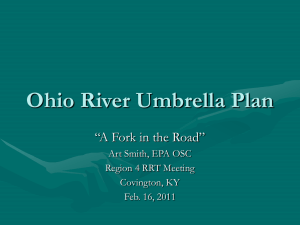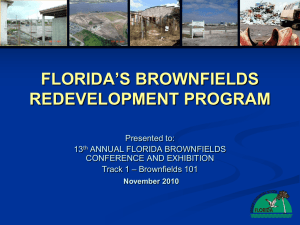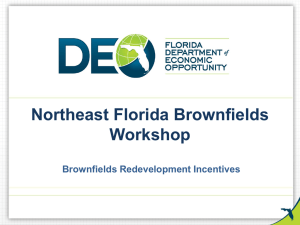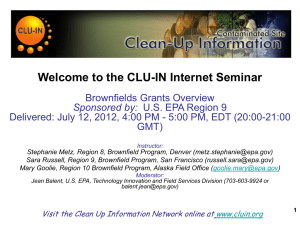Brownfields_BLLUP_4 - Cleveland State University
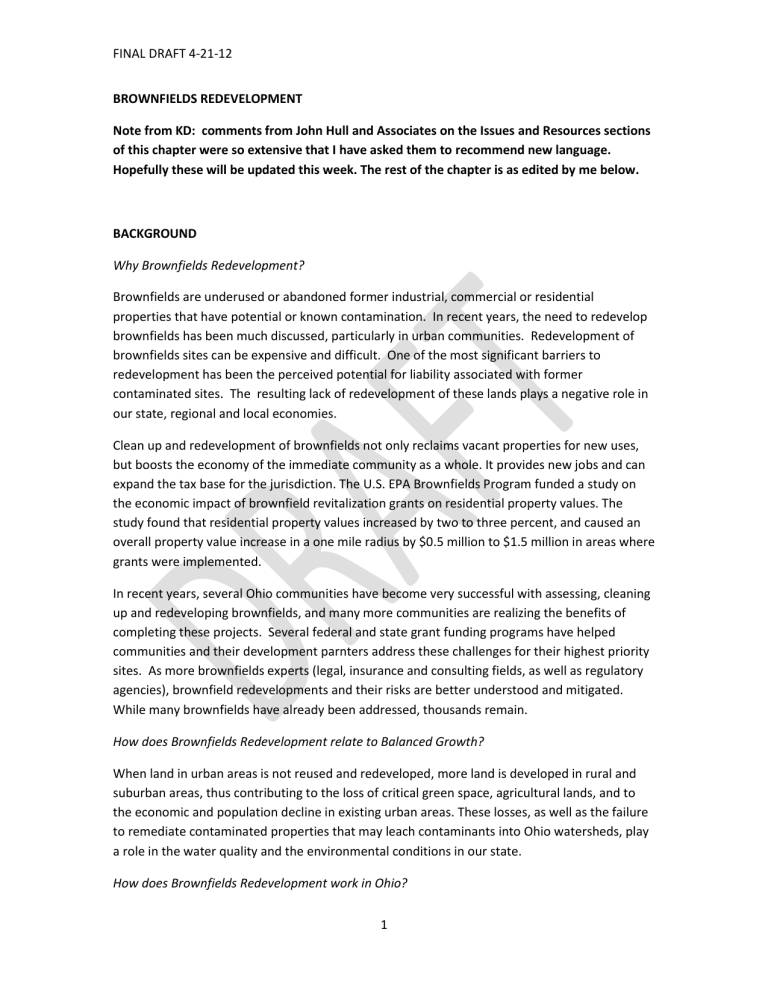
FINAL DRAFT 4-21-12
BROWNFIELDS REDEVELOPMENT
Note from KD: comments from John Hull and Associates on the Issues and Resources sections of this chapter were so extensive that I have asked them to recommend new language.
Hopefully these will be updated this week. The rest of the chapter is as edited by me below.
BACKGROUND
Why Brownfields Redevelopment?
Brownfields are underused or abandoned former industrial, commercial or residential properties that have potential or known contamination. In recent years, the need to redevelop brownfields has been much discussed, particularly in urban communities. Redevelopment of brownfields sites can be expensive and difficult. One of the most significant barriers to redevelopment has been the perceived potential for liability associated with former contaminated sites. The resulting lack of redevelopment of these lands plays a negative role in our state, regional and local economies.
Clean up and redevelopment of brownfields not only reclaims vacant properties for new uses, but boosts the economy of the immediate community as a whole. It provides new jobs and can expand the tax base for the jurisdiction. The U.S. EPA Brownfields Program funded a study on the economic impact of brownfield revitalization grants on residential property values. The study found that residential property values increased by two to three percent, and caused an overall property value increase in a one mile radius by $0.5 million to $1.5 million in areas where grants were implemented.
In recent years, several Ohio communities have become very successful with assessing, cleaning up and redeveloping brownfields, and many more communities are realizing the benefits of completing these projects. Several federal and state grant funding programs have helped communities and their development parnters address these challenges for their highest priority sites. As more brownfields experts (legal, insurance and consulting fields, as well as regulatory agencies), brownfield redevelopments and their risks are better understood and mitigated.
While many brownfields have already been addressed, thousands remain.
How does Brownfields Redevelopment relate to Balanced Growth?
When land in urban areas is not reused and redeveloped, more land is developed in rural and suburban areas, thus contributing to the loss of critical green space, agricultural lands, and to the economic and population decline in existing urban areas. These losses, as well as the failure to remediate contaminated properties that may leach contaminants into Ohio watersheds, play a role in the water quality and the environmental conditions in our state.
How does Brownfields Redevelopment work in Ohio?
1
FINAL DRAFT 4-21-12
The Ohio legislature and Ohio EPA have attempted to address the brownfields problem by enacting and implementing a program to encourage cleanup and reuse of brownfields sites. The program allows the volunteer (owner, developer, municipality, etc.) that is doing the remediation to clean up a property, under the supervision of an environmental professional certified by the Ohio EPA. When the “certified professional” certifies that the site meets the state’s standards for its intended future use, they will issue a “No Further Action” letter for Ohio
EPA review. The volunteer may also seek a “covenant not to sue” from Ohio EPA promising that the state will not pursue legal action regarding the cleanup performed at the site.
This covenant provides state civil liability protection for the environmental cleanup but does not protect the volunteer from liability from third parties, or the U.S. EPA. (Ohio EPA has negotiated a process with U.S. EPA, known as the VAP MOA-Track, through which a volunteer may obtain protection from the U.S. EPA as well by participating in a variation of the cleanup program that requires direct supervision by Ohio EPA and includes opportunities for public participation in the process.).
ISSUES
• There are several definitions of the term “brownfield”. According to the Small Business
Liability Relief and Brownfields Revitalization Act, “brownfield” means real property, the expansion, redevelopment, or reuse of which may be complicated by the presence or potential presence of a hazardous substance, pollutant, or contaminant. According to McKinney’s
Environmental Science, brownfields are old, run-down, and abandoned parts of a city or town. A
Brownfield is commonly defined as an “abandoned, idled, or underutilized property where redevelopment is in part inhibited by actual or perceived environmental contamination.”
• This lack of consistency makes it difficult for communities to identify sites and decide what to do with them.
• There are many programs and initiatives, at the federal, state, and local levels, designed to encourage the redevelopment of brownfield land. These initiatives tend primarily to address the liability concerns and the financial costs associated with redevelopment of contaminated properties. They provide methods and incentives for cleanup, such as reduced cleanup standards, and some limited protection from future liability. Some initiatives focus on providing funding for cleanups through loans, grants, tax increment financing, and other methods.
•Brownfields are not being redeveloped at the rates necessary to maintain the economic and environmental health of the region, in part because existing programs do not address many important barriers to their redevelopment. For example, existing initiatives do not always acknowledge that many potential brownfield redevelopers are seeking large sites on which to develop industrial and commercial parks whereas most brownfields are located on small, sometimes oddly configured sites. The programs do not address other reasons brownfields may not be chosen for redevelopment, such as tax incentives in less developed areas, local crime rates, convenience of the site to managers’ residences, etc.
2
FINAL DRAFT 4-21-12
• Existing programs have had difficulty matching potential users to appropriate sites.
• Citizen groups are sometimes reluctant to get involved. This is partly because there are at least two strongly held views regarding the cleanup programs. First, some feel that the surrounding neighborhood needs to encourage redevelopment of brownfields to improve the area for those who live there. Others feel that the laws that encourage redevelopment by allowing cleanup at risk based standards are less protective of public health. The tension between these positions can lead to inaction.
• A stigma is attached to brownfields that may result in difficulty finding tenants, especially in residential developments. Community involvement can mitigate stigma issues and assist with effective property marketing strategies. In most cases, success is enhanced when carefully orchestrated public outreach is implemented from the outset.
• Even when existing programs help lead to the redevelopment of a brownfield, there is some concern about the ability of local governments to enforce the use associated with the cleanup standard the site attained. Some question the actual and legal longevity of deed restrictions because of potential difficulty with enforcement.
• For many reasons, including decentralization of redevelopment efforts, lack of definitional clarity, and lack of funding, communities have not developed or maintained useable brownfields inventories. For example, in Cuyahoga County, there is an inventory of contaminated lots which is searchable for a number of specific brownfields characteristics but not for all brownfield sites in an area.
• Despite the attempts by Ohio EPA and federal and local governments to create some comfort for business and banks to get involved in redevelopment, many still fear the cleanup costs and liability associated with getting involved in contaminated properties.
• A promise from the State of Ohio not to sue may not be adequate in negating lender and developer concerns; advances in environmental insurance help curb the risk element and thus makes such developments more attractive to lenders and developers; furthermore it is likely the lower risk will equate to reduced financing costs.
RECOMMENDATIONS
• Establish inter-agency taskforces or designating lead agencies in order to streamline decision making and coordinate the multiple regulatory issues connected with projects
• Improve systems for identification of sites and continue to expand inventories of sites and site characteristics
• Use planning to identify areas and sites for redevelopment
• Facilitate the matching of sites to potential users
3
FINAL DRAFT 4-21-12
• Change statutes and programs to address the non-environmental barriers to brownfield redevelopment that are not addressed in existing programs
• Educate the public, businesses, and redevelopers about the benefits and opportunities that lie with existing programs
EXAMPLE REGULATIONS FOR GUIDANCE
We have found no model regulations specifically on brownfields redevelopment issues at the local level. Most law and regulation in this area is at the state and federal level. More information on brownfields issues in general and on state and federal brownfields redevelopment initiatives may be obtained from the resources listed below.
RESOURCES
US EPA Brownfields and Land Revitalization, Website: http://www.epa.gov/brownfields
• EPA’s Brownfields Program is designed to empower states, communities, and other stakeholders in economic redevelopment to work together in a timely manner to prevent, assess, safely clean up, and sustainably reuse brownfields. Brownfields are real property, the expansion, redevelopment, or reuse of which may be complicated by the presence or potential presence of a hazardous substance, pollutant, or containment. Through this EPA program, technical assistance, funding, information on laws and statutes and other resources are provided. Grants are offered to leverage money for assessments, job training, clean up and revitalization.
• Through its Brownfields Assessment, Cleanup & RLF Pilots/Grants, US EPA has funded many projects in Ohio, including projects in Akron, Cleveland, Columbus, Dayton, Elyria, Fostoria,
Girard, Hamilton, Lancaster, Lima, Lincoln Heights, Mahoning County, Mansfield, Reading,
Sebring, Springfield, Toledo, and Youngstown. EPA includes in its “success stories” projects in
Cuyahoga County and Lima, Ohio.
US EPA Region 5, Website: http://www.epa.gov/R5Brownfields
• Includes contact information for officials involved in brownfields redevelopment throughout the region, including both local and rural areas.
Ohio EPA Voluntary Action Program, Website: http://web.epa.state.oh.us/derr/volunt/volunt.html
• This program was designed to provide a way to investigate possible contamination at a site, clean it up if necessary under the supervision of a certified environmental professional, and
4
FINAL DRAFT 4-21-12 receive a promise from the State of Ohio that no more cleanup is needed. The promise, called a
“covenant not to sue,” protects the participant from liability to the State of Ohio, but it does not protect against liability to third parties or US EPA. Ohio EPA has negotiated a Memorandum of
Agreement with US EPA to provide a process by which a participant may derive some protection from federal liability by following a cleanup process overseen directly by Ohio EPA personnel and includes opportunities for public review of and comment on documents regarding the site.
Clean Ohio Fund, Brownfield Revitalization Program, website: http://clean.ohio.gov/BrownfieldRevitalization/
• The Clean Ohio Fund’s Brownfield Revitalization Program has two separate funds that help the remediation of brownfields; the Clean Ohio Assistance Fund (COAF), and the Clean Ohio
Revitalization Fund (CORF). They are financial tools for former commercial or industrial facilities which were developed to provide funding for brownfield clean up activities which are a key component in brownfield redevelopment. Brownfield redevelopment allows a community to reclaim and improve its lands, making previously developed property viable for new development.
Ohio Brownfield Funding Chart http://clean.ohio.gov/BrownfieldRevitalization/Documents/CommonBrownfieldFundingSourcesi nOhioJune2011.pdf
Ohio Environmental Protection Agency, Division of Emergency and Remedial Response; Tel: 614-
644-2924; Web: http://www.epa.state.oh.us/derr/SABR/Brown/brown.html
Brownfields One Stop Shop (BOSS), Great Lakes Environmental Finance Center, Cleveland State
University; Tel: 330-528-3237; Web: www.glefc.org
SIDEBAR:
Cuyahoga County
• The Cuyahoga County Planning Commission developed its Brownfields GIS (Geographic
Information System) as a project through its Brownfields Pilot Demonstration project. The system, begun in 1995 and updated in its current status as an internet application, was designed to promote both economic development of industrial property and to provide information to the public on the status of industrial and commercial sites. The site provides an array of environmental data which may be useful in transaction screening analyses and Phase I assessments. Economic factors and certain infrastructure attributes can also be screened through radial searches featuring demographics, census blocks, travel time, roadways, utility, and rail lines.
5
FINAL DRAFT 4-21-12
• The District One Public Works Integrating Committee (DOPWIC) oversees implementation of the State Capital Improvement Program (Issue 2) in Cuyahoga County. In addition to providing financing for capital infrastructure projects, the DOPWIC evaluates and selects brownfields redevelopment projects for financial assistance.
Cuyahoga County Department of Development, Brownfield Division http://www.development.cuyahogacounty.us/en-US/brownfield-redevelopment.aspx
The County has appropriated $17.2 million in Brownfield Redevelopment Funds for 25 projects. The Return on Investment, which is generated from income, property and sales taxes, is projected to exceed $30 million
The County has provided Community Assessment Initiative funding to 45 projects
They offer multiple types of grants for commercial and industrial redevelopment, and brownfield prevention and site expansion
Cincinnati-American Can Building (photo: ODOD). American Can Building, LLC, was awarded a loan from the Ohio Department of Development Brownfield Revolving Loan Fund to conduct remediation activities at the 2.3-acre American Can property. The completed Factory Square project includes apartments, retail, townhomes and office space.
6
FINAL DRAFT 4-21-12
Columbus-AC Humko / Harrison Park (photo: ODOD) Developed as an industrial property in 1900 and then used as a vegetable oil refinery from 1920 to 2001, this property was transformed into a promising residential development called Harrison Park. A $3 million Clean Ohio Revitalization
Fund grant provided crucial money to do the necessary clean-up of the once-problematic property.
Chillicothe-Former CSXT Chillicothe Yard (photo: ODOD) In 2003, the City of Chillicothe was awarded a Clean Ohio Revitalization Fund grant to remediate soil and groundwater on the eight acre site. The remediated site is now a community transit center, with a modern bus terminal, and a maintenance facility and equipment building.
7
FINAL DRAFT 4-21-12
Cuyahoga Falls-High Bridge Glens (photo: ODOD) In the 1800s, this 7.48-acre site served as the location for an amusement park. The Farris Development, with financial support from the Clean
Ohio Revitalization Fund, is committed to a mixed use development that will include condominiums, retail space, parking, and a 2-acre park with a bridge overlooking the Cuyahoga
River Gorge and a boardwalk along the river.
8

